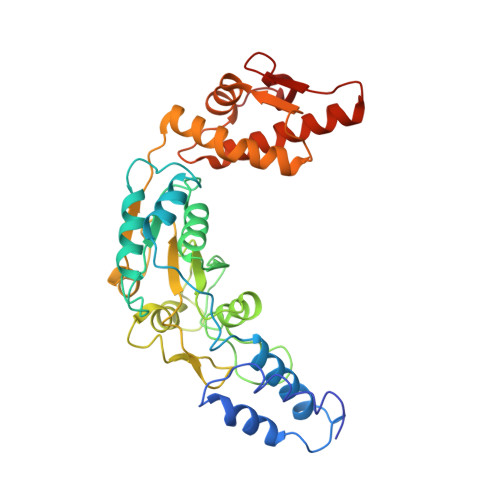New insights into structural and functional relationships between LonA proteases and ClpB chaperones.
Rotanova, T.V., Andrianova, A.G., Kudzhaev, A.M., Li, M., Botos, I., Wlodawer, A., Gustchina, A.(2019) FEBS Open Bio 9: 1536-1551
- PubMed: 31237118
- DOI: https://doi.org/10.1002/2211-5463.12691
- Primary Citation of Related Structures:
6N2I - PubMed Abstract:
LonA proteases and ClpB chaperones are key components of the protein quality control system in bacterial cells. LonA proteases form a unique family of ATPases associated with diverse cellular activities (AAA + ) proteins due to the presence of an unusual N-terminal region comprised of two domains: a β-structured N domain and an α-helical domain, including the coiled-coil fragment, which is referred to as HI(CC). The arrangement of helices in the HI(CC) domain is reminiscent of the structure of the H1 domain of the first AAA + module of ClpB chaperones. It has been hypothesized that LonA proteases with a single AAA + module may also contain a part of another AAA + module, the full version of which is present in ClpB. Here, we established and tested the structural basis of this hypothesis using the known crystal structures of various fragments of LonA proteases and ClpB chaperones, as well as the newly determined structure of the Escherichia coli LonA fragment (235-584). The similarities and differences in the corresponding domains of LonA proteases and ClpB chaperones were examined in structural terms. The results of our analysis, complemented by the finding of a singular match in the location of the most conserved axial pore-1 loop between the LonA NB domain and the NB2 domain of ClpB, support our hypothesis that there is a structural and functional relationship between two coiled-coil fragments and implies a similar mechanism of engagement of the pore-1 loops in the AAA + modules of LonAs and ClpBs.
Organizational Affiliation:
Shemyakin-Ovchinnikov Institute of Bioorganic Chemistry, Russian Academy of Sciences, Moscow, Russia.














